- MENU -
The Profound Bond Between Kabuki and Aoyama Gakuin(AGU)
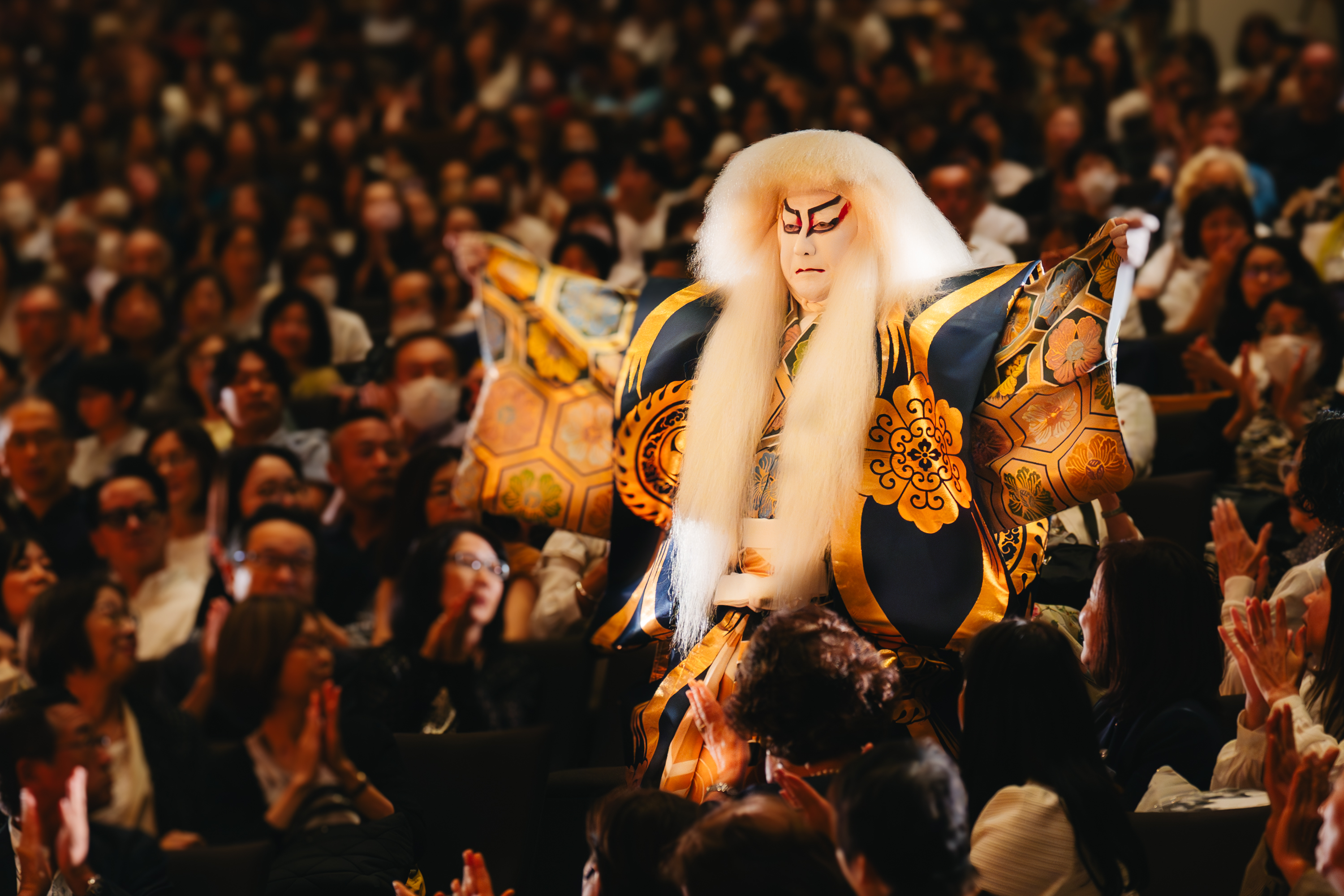
On September 28, 2024, a special Kabuki performance, “Celebrating with Aogaku Kabuki”, was held at the Aoyama Gakuin Auditorium to commemorate the 150th anniversary of Aoyama Gakuin. This event symbolized the deep, historical connection between Kabuki and Aoyama Gakuin. By blending traditional performing arts with an educational environment, the performance highlighted the potential for cultural preservation and innovation. The Kabuki actors, proud alumni of Aoyama Gakuin, graced the stage as "local heroes," captivating the audience with their artistry.

Bringing Kabuki Closer: A New Approach
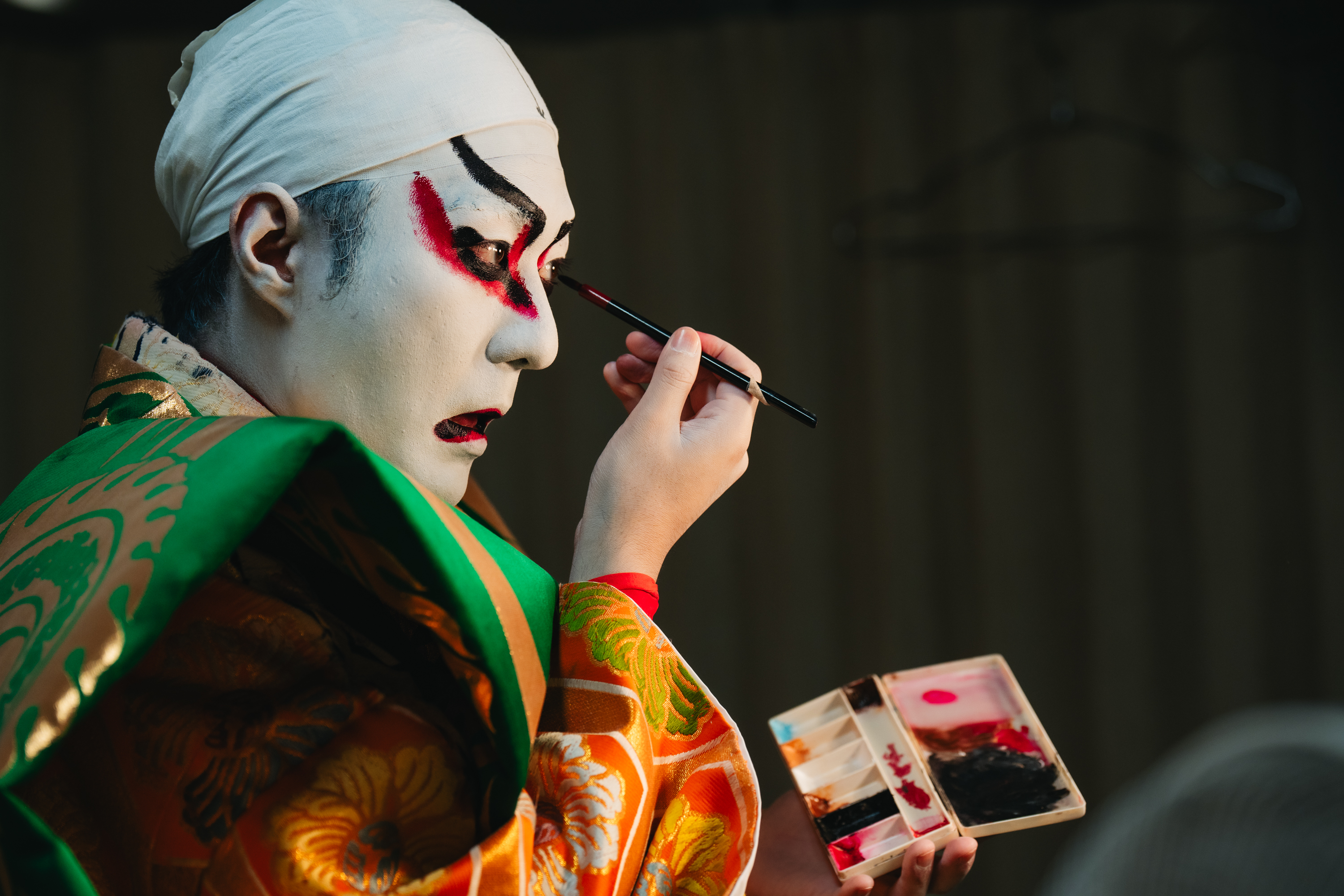
Breaking away from the traditional theater setting, this performance was uniquely staged in the school auditorium. This innovative approach embodied the actors’ desire to make Kabuki more accessible, offering audiences a rare opportunity to experience this iconic art form in an intimate and approachable environment.

Renjishi(The Father and Son Shishi Lions): A Tale of Parental Bonds
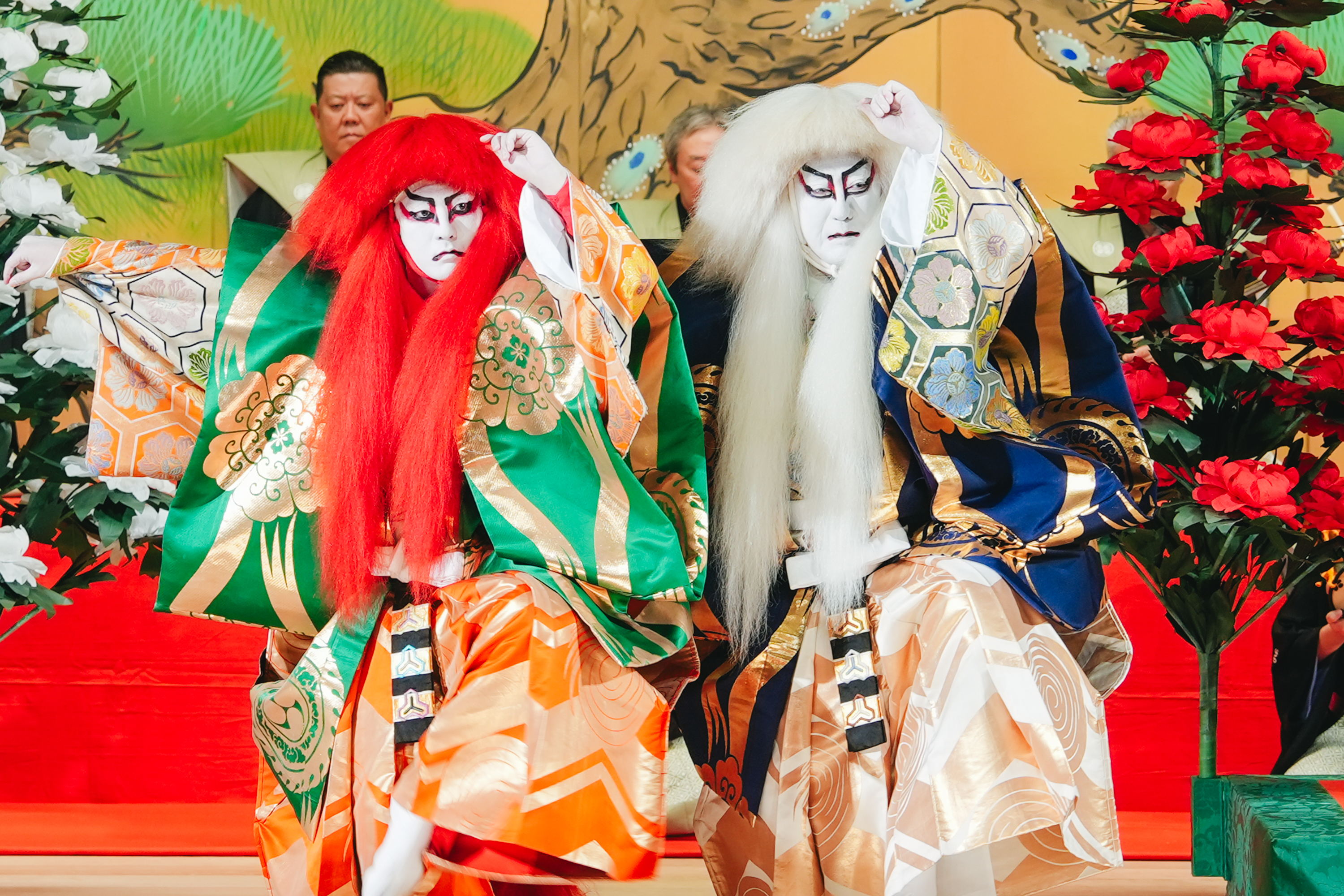 Renjishi(The Father and Son Shishi Lions) Performance by Nakamura Shikan (Father) and Nakamura Hashinosuke (Son)
Renjishi(The Father and Son Shishi Lions) Performance by Nakamura Shikan (Father) and Nakamura Hashinosuke (Son) The main act was Renjishi(The Father and Son Shishi Lions), a Kabuki masterpiece that vividly portrays the deep bond between parent and child. The story follows a parent lion who challenges their cub with rigorous trials, highlighting the cub’s resilience and growth. This universal theme resonated deeply with the audience. The performance featured Nakamura Shikan and his three sons—Nakamura Hashinosuke, Nakamura Fukunosuke, and Nakamura Utanosuke—who brought the generational legacy of Kabuki to life on stage.
 Renjishi(The Father and Son Shishi Lions) Performance by Nakamura Shikan (Father) and Nakamura Hashinosuke (Son)
Renjishi(The Father and Son Shishi Lions) Performance by Nakamura Shikan (Father) and Nakamura Hashinosuke (Son) International Exchange Through English Lectures
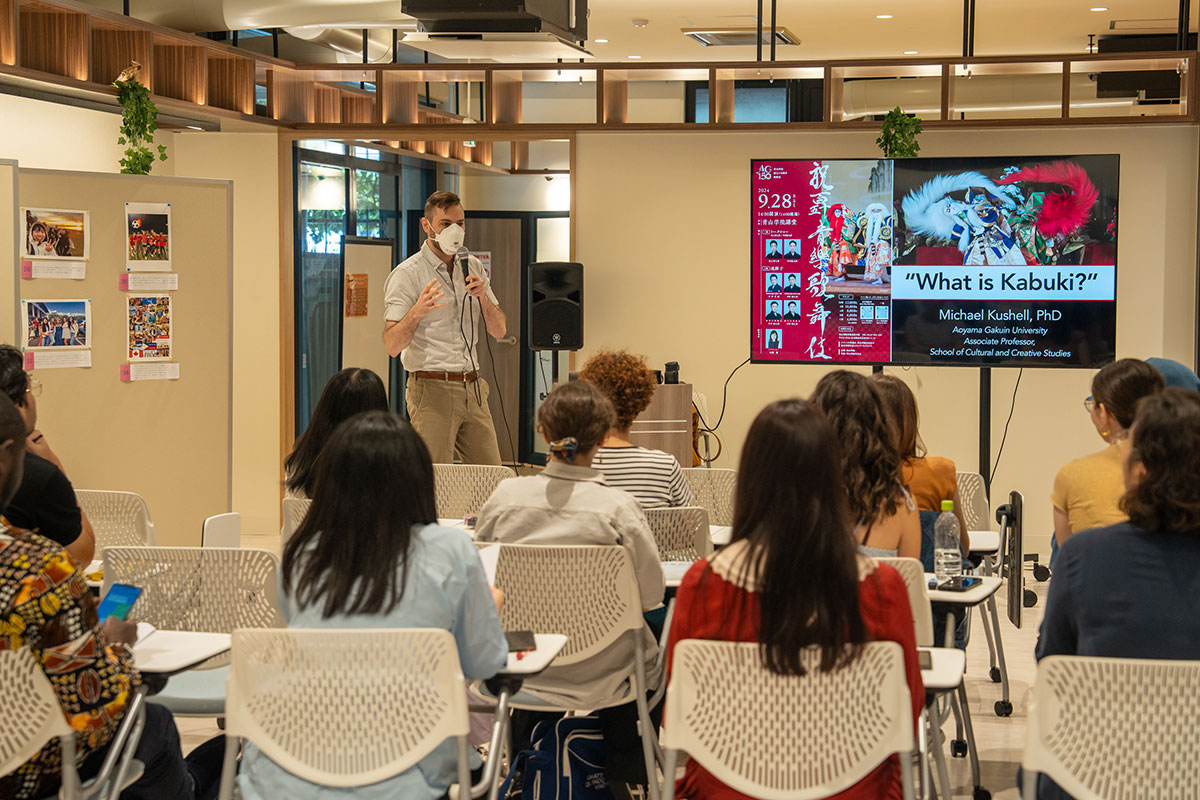
International exchange students studying at Aoyama Gakuin University were specially invited to the event, with an English-language lecture on Kabuki held prior to the performance. This initiative provided the students with a deeper understanding of Japanese culture and allowed them to experience its profound beauty firsthand.
This effort was made possible by Associate Professor Michael Kushell, who specializes in the study of Japanese performing arts at AGU. The lecture served as a "gateway to Kabuki," fostering cultural appreciation and creating a meaningful opportunity for international exchange.

From “Watching” to “Doing”: “Aogaku Kabuki” and the Power of Community
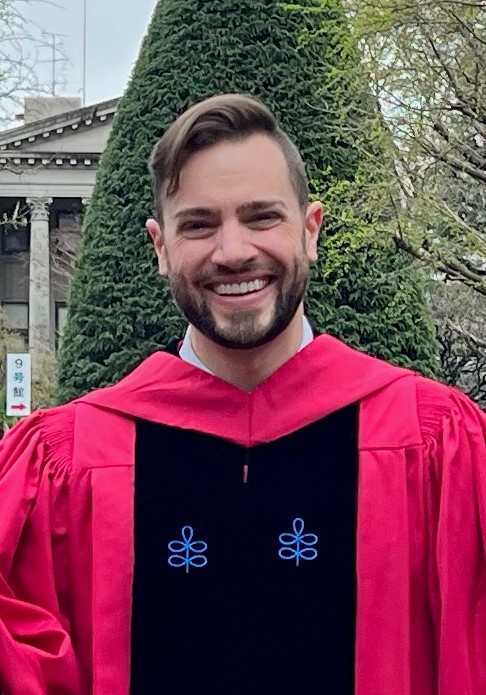
Michael Kushell
Associate Professor
Department of Cultural and Creative Studies, School of Cultural and Creative Studies, Aoyama Gakuin University
“Kabuki isn’t something you watch, it’s something you do.” Since I first lived in Japan as a study abroad student myself, I’ve spent much of my time here researching a regional, amateur form of kabuki known as “local” or “ji-” kabuki, where these words serve as a guiding philosophy. True to this saying, annual ji-kabuki performances are festive celebrations produced through the active participation of local communities, on all sides of the stage—not only actors who pour their sweat and tears into each performance, but audience members who shout encouragement and shower their friends onstage with paper-wrapped coins throughout, as well as countless backstage supporters who tie everything together behind the scenes. But as it recently became clear to me, this kind of locally produced collaborative energy is by no means limited to regional, amateur performances—indeed, it was just this kind of participatory festival atmosphere that was on full display at the recent performance of Aoyama Gakuin’s own “local” kabuki, held to commemorate the school’s 150th anniversary.
To be sure, just as Aoyama Gakuin’s campus in the heart of Shibuya is about as far as one can get from the Japanese countryside, after lifetimes of professional training, the renowned kabuki actors who performed here, are in a league of their own. Yet as many who entered the distinctly local venue of the Aoyama Gakuin Auditorium on September 28 will attest, the production of “Aogaku Kabuki” was marked by a sense of collective celebration—and of collective doing—that is unlikely to be found at any other professional kabuki performance. From the moment Aoyama Gakuin’s own “hometown” actors (who just happen to be top professionals) took the stage, the school community welcomed its graduates back to campus with a kind of ceaseless passion reserved for local heroes. In turn, throughout the entirety of their powerful, heartfelt, sweat-drenched performances, the actors fed this energy back into the audience, in a dynamic and unifying cycle. All the while, volunteers from across Aoyama Gakuin worked tirelessly behind the scenes to make the event a rousing success, even long after the curtains had closed.
Before the performance, I was honored to give a pre-performance lecture to an international group of students just beginning their own journeys studying abroad at Aoyama Gakuin University, almost all of whom would be seeing kabuki for the first time. Rather than introducing kabuki as a lofty form of “high art” or as a static, unchanging tradition, I presented the genre as I’ve come to understand it after 15 years of researching ji-kabuki—as a living, breathing practice with deep but dynamic local connections, in which the students themselves would be actively participating. As the curtains opened, and students were surrounded by the lively audience shouting of actors’ family names (“Narikoma-ya!”), and then suddenly face-to-face with several breathtakingly gorgeous “lions,” so close they could be touched, I was thrilled to see the students themselves actively engaging with every turn of the performance—gasping to one another with awe at each pose, whispering their excitement to their neighbors, and loudly cheering along with other members of the hometown crowd. In other words, not simply watching but “doing” kabuki. For these lucky students, as well as for myself, it was a truly unforgettable experience.

Opening the Door to Kabuki: Associate Professor Kushell’s Pre-Lecture and the Moving Experience of Renjishi(The Father and Son Shishi Lions)

Elfie Climent
Exchange student from the Institut d'Études Politiques de Grenoble , France.
School of International Politics, Economics and Communication
Attending a Kabuki performance at Aoyama Gakuin (AGU) constitutes an immersive journey into Japan’s rich theatrical heritage, wherein drama, music, and dance coalesce to narrate tales of romance, tragedy, and heroism. The pre-lecture was an enlightening primer, akin to a guided tour through the intricate history and unique elements that define Kabuki, significantly enriching the audience’s comprehension and appreciation of the ensuing spectacle.
The pre-lecture commenced with an exposition on Kabuki’s origins, tracing its genesis to the early 17th century and highlighting its metamorphosis from a popular entertainment medium for the common populace to a celebrated and sophisticated art form. The lecturer, Associate Professor Michael Kushell, was absolutely fantastic and passionate, sharing intricate details about the elaborate costumes and makeup. His enthusiasm was contagious, instilling in us a profound envy to learn more about Kabuki. Insights into the significance of the onnagata—male actors portraying female roles—and their rigorous training added depth to the subsequent performance.
When the curtain ascended for the "Renjishi(The Father and Son Shishi Lions)" performance, the transition from lecture to live performance felt almost magical. The vibrant costumes, dynamic choreography, and powerful line delivery in an exaggerated yet expressive manner were striking. The actors' movements were meticulously choreographed, each gesture amplified by the traditional music played live on stage. The haunting sounds of the shamisen, coupled with the rhythmic beats of the taiko drums, created an auditory landscape that was both otherworldly and mesmerizing.
One particularly impressive scene was when the actors portraying the lions engaged in an extended sequence of head-turning movements. The endurance and precision required to maintain this repetitive action without breaking character showcased the incredible physical discipline and skill of the performers. It was a moment that left the audience in awe, highlighting the dedication and artistry inherent in Kabuki theater.
As an international student, I felt deeply honored to attend such a culturally significant performance. The experience offered a rare and profound insight into Japanese art and tradition, making me feel privileged to witness it firsthand. The communal aspect of the performance was equally surprising and delightful; hearing the audience’s audible reactions and vocal encouragements during key moments added a layer of interactivity and shared joy that is often absent in Western theater. It fostered a sense of unity and collective engagement, enhancing the overall atmosphere and making the performance even more memorable.
In conclusion, the pre-lecture was not only informative but instrumental in enhancing the audience’s engagement with the "Renjishi(The Father and Son Shishi Lions)" Kabuki performance. It provided context and clarity, facilitating a profound appreciation of the artistry and cultural significance of Kabuki. The performance was a testament to the enduring allure of traditional Japanese theater, leaving a lasting impression with its blend of spectacle, emotion, and historical depth, and filling the audience with joy and cultural enrichment.
Thank you to the International Commons and AGU for offering the opportunity for the international students to attend to this masterpiece.

Supporting Education Through Charity
Proceeds from this performance were donated to the Aoyama Gakuin Mandai Fund, providing scholarships to students in need. This initiative reflects Aoyama Gakuin’s commitment to its mission of “ensuring students never have to stop learning.”
The Historic Connection Between Kabuki and Aoyama Gakuin
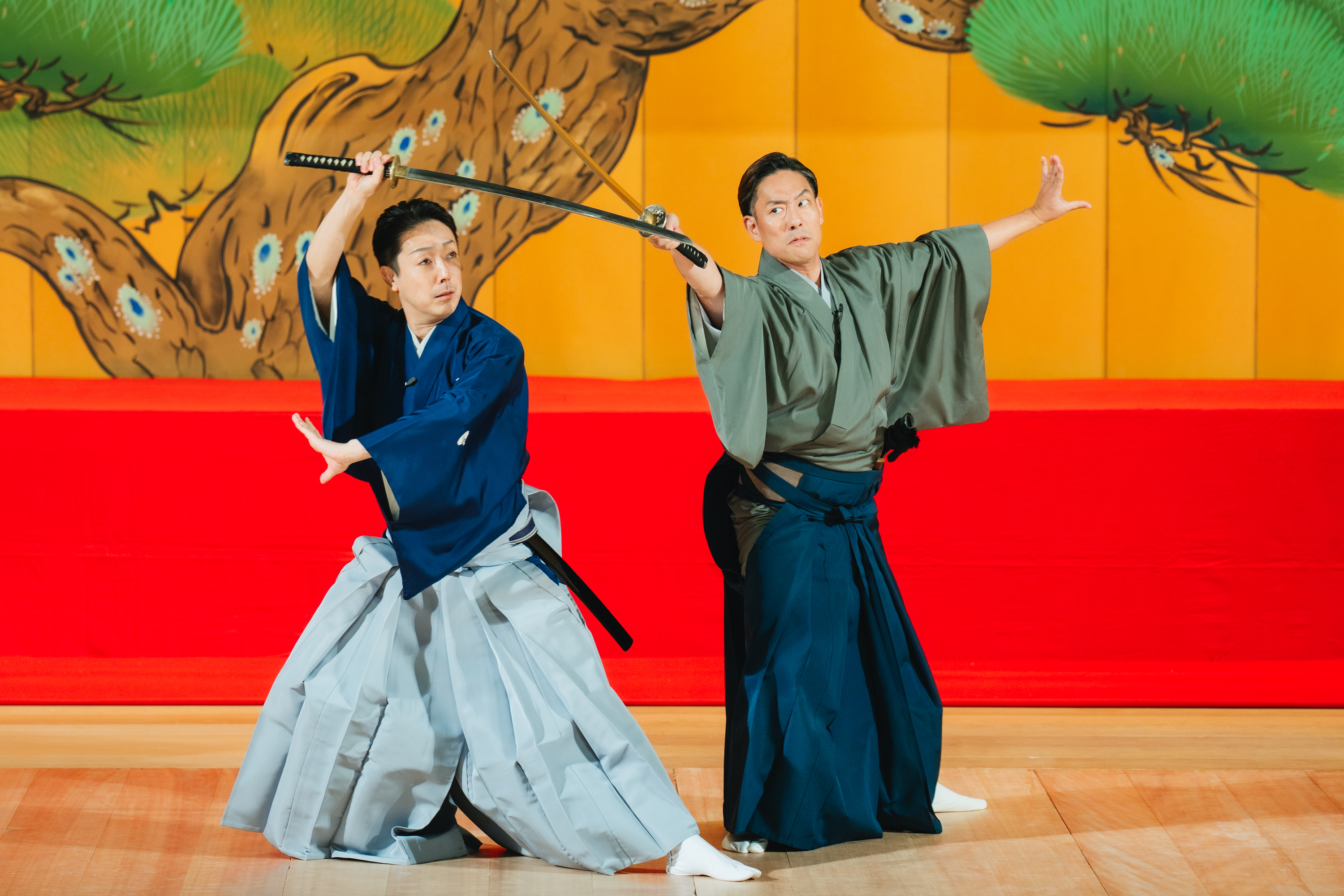 Talk Show with Onoe Kikunosuke and Nakamura Kankuro
Talk Show with Onoe Kikunosuke and Nakamura Kankuro
The connection between Aoyama Gakuin and Kabuki began with the enrollment of the 12th Ichikawa Danjuro. Over time, many Kabuki actors and their children have also chosen to study here, strengthening the bond between Aoyama Gakuin and the Kabuki world. This tradition continues today, with current students actively performing as professional Kabuki actors.
Aoyama Gakuin holds so many Kabuki actor alumni that an entire troupe could be formed from its graduates. This remarkable connection symbolizes the university’s role as both an educational institution and a "spiritual home" for these performers, offering lifelong support and inspiration.
 Talk Show with Onoe Kikunosuke and Nakamura Kankuro
Talk Show with Onoe Kikunosuke and Nakamura Kankuro